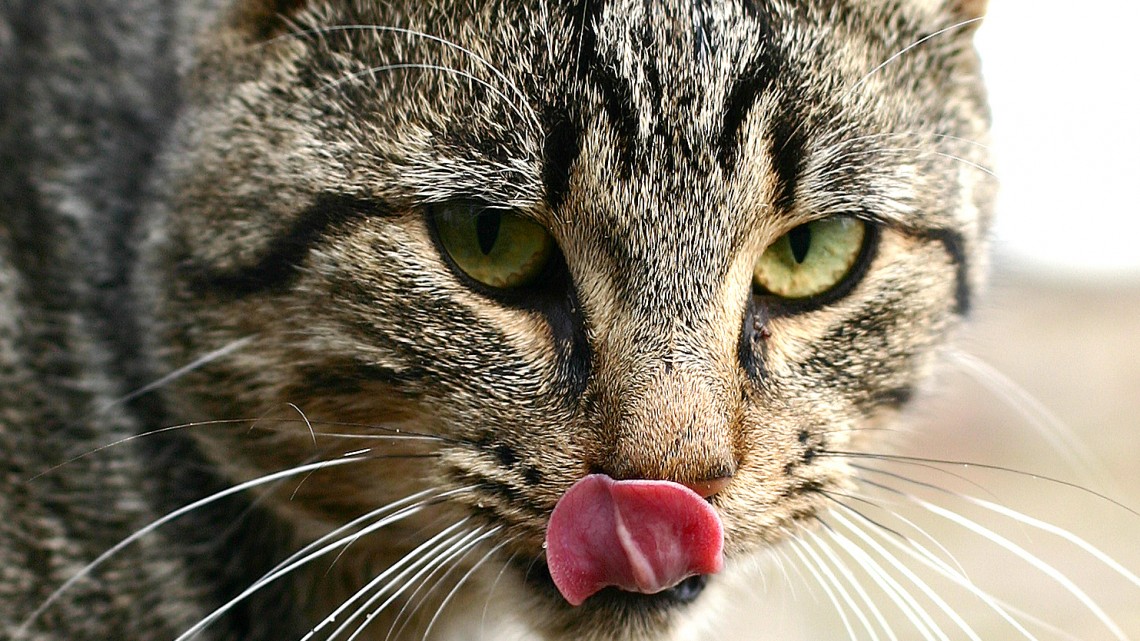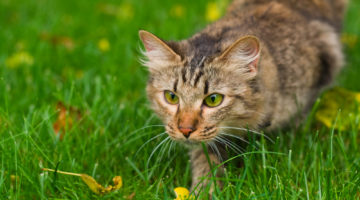If your cat is like most, he probably loves fish. But how much and which varieties should he eat?
It’s one of the icons of cat culture – a cat licking his chops while sitting satisfied over a fish skeleton. Fish is actually an acquired taste, but many cats acquire it to an extreme. Some may even start refusing everything else. What’s up with that?
It may appear a bit of a mystery why cats would go over- board for fish. Given that most cats dislike getting wet, fish seems an odd choice for this descendent of the desert. In the natural world, in fact, only one feline species (the Southeast Asian fishing cat) actually fishes for a living.
As it turns out, fish contains plenty of taurine, high quality protein and fat. Because feline taste buds are keyed to protein and fat, fish is therefore very palatable to them. Cold water fish such as salmon, herring, menhaden, cod and sardines contain large amounts of omega-3 fatty acids (healthy anti-inflammatory oils) that help keep cell membranes flexible in chilly temperatures.
The tuna dilemma
Like plain meat, however, fish by itself is not a complete or healthy diet. A lot of cats love tuna but tuna packed for human consumption has very little calcium, which is important not only for bones but also heart and nerve function. Tuna is high in phosphorus and deficient in fat-soluble vitamins A, D and E as well as several B vitamins. When packed in oil, tuna can cause a severe vitamin E deficiency resulting in a very painful inflammatory condition called steatitis. Albacore tuna has higher levels of mercury than light tuna, but living at the top of the food chain increases the mercury risk in all tuna. Among fish, tuna is also relatively low in omega-3 fatty acids. So “people tuna” is not a good choice for cats, other than as a small and very occasional treat.
Wild salmon only
Canned salmon contains bones, but still lacks several vitamins. Most salmon, whether fresh, canned or in cat food, comes from farmed fish (unless it’s specifically designated as wild). As with other intensive factory farms, salmon live in crowded pens and are very susceptible to diseases and parasites. They’re fed an unnatural diet supplemented with antibiotics, anti-fungals and dyes to turn their gray flesh salmon-colored. Farmed salmon contains the same amount of omega-3 fats as wild salmon, but because they are 50% fatter than their wild cousins, they also contain six times more omega-6, the pro-inflammatory form of EFA. Common water pollutants such as PCBs (a cancer-causing relative of dioxin), pesticides, and other chemicals are present in farmed salmon at ten times the levels found in wild fish. These contaminants will be present in any product made with farmed fish, including pet food. When feeding your cat salmon, therefore, read the label before buying a product and make sure it’s wild fish.
More fish facts
- Small fish that are canned whole, like sardines, herrings and anchovies, are better balanced because they contain bones and some internal organs (though usually not the heads). When packed in oil, however, they can still create fat-soluble vitamin deficiencies, especially vitamin E, if fed to excess.
- Poor quality dry foods often contain fish meal as both a flavoring and a source of omega-3 fatty acids. All fish meal coming into the U.S. must be preserved, and the preservative of choice is ethoxyquin, a synthetic chemical that some have linked to health problems in animals. A safer, more natural preservative is available, but it is more expensive so mainly high-end natural brands use it – feed these instead.
Up to 15% of your cat’s total diet can be an added protein such as fish.
- Many cats are sensitive or even allergic to fish. In fact, it is one of the top three most common food allergens. Part of the reason is that fish which has not been properly stored (and may be the very fish that ends up in commercial cat foods) may contain high levels of histamine, a protein involved in allergic reactions. Fish sensitivity most often causes vomiting and/or diarrhea, but occasionally it makes itself known via FLUTD (feline lower urinary tract disease), including cystitis (bladder inflammation), crystals and stones. These are uncomfortable for all cats, and potentially life-threatening in males, for whom a urinary blockage can be fatal.
- There’s a link between feeding poor quality fish-based canned cat foods and the development of hyperthyroidism, a disease of the thyroid gland, in older cats. Multiple factors may contribute to the problem:
1. Marine fish are naturally high in iodine; excess iodine has been implicated in hyperthyroidism in people and is suspected in cats.
2. The lining of some pop-top pet food cans may contain BPA (bis-phenol A), which is thought to be a factor in hyperthyroidism.
3. Foods containing fish and giblets are more strongly associated with hyperthyroidism than other flavors.
4. Due to pollution, marine fish often contain high levels of other chemicals, including PBDEs (polybrominated diphenyl ethers), synthetic fire retardants linked to hyperthyroidism in cats.
- Predatory fish at the top of the food chain may contain very elevated levels of heavy metals (including mercury) as well as PCBs, pesticides, and other toxins. They include tuna, tilefish (which is among the species referred to as “ocean whitefish”), king mackerel, shark, and swordfish. Mercury has even been found in freshwater fish like trout and perch.
Because of parasitism, feeding raw fish is never a good idea. Raw salmon, particularly from farmed fish, often contains pathogenic bacteria.
Feeding tips
1. A small amount of fish or seafood as a flavoring or treat, like shrimp or chopped sardines, is not a problem (unless your cat is allergic) and provides important nutrients.
2. If buying packaged cat food, be sure to choose a premium product with ingredients that are as natural and high in quality as possible.
3. Cooked fish can be used in place of meat in a homemade recipe as long as you select low-mercury species such as wild salmon, sole, cod, had- dock, tilapia, and pollock, and most shellfish and crustaceans.
4. If you are cooking healthy, wild-caught fish for yourself, it’s perfectly reasonable to share a little with your cat.
An entirely fish-based diet is not natural, but if your cat likes it, there’s no reason it can’t be included in your rotation of flavors and varieties. In fact, up to 15% of your cat’s total diet can be an added protein such as fish. Just be sure to do your home- work first. As with anything else, knowledge and moderation are the keys!







No Comment